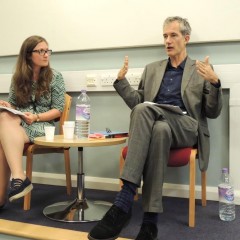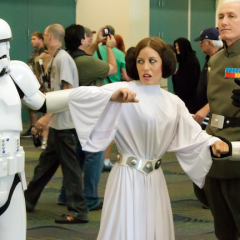Geoff at Birkbeck, Dyer in Academia
by Alexander Williamson 11 July 2014 Around fifty academics, students and interested readers hunkered down for Colours of Memory: the first international conference to examine twenty-five years of Geoff Dyer being a living, breathing and – more importantly – published writer. The purpose: to use an academic context to reframe Dyer’s work, focusing on his key texts as exploratory avenues to contemporary debates in literary and photographic criticism. The entire event gained an extra dimension as Dyer, fresh off the plane from Los Angeles, attended it from start to finish. To read Dyer’s work academically might be no easy task, given his virtually patricidal relationship with – to paraphrase his own words – ‘unimaginative criticism’. In Out of Sheer Rage (1994) he writes: ‘it kills everything it touches. Walk around a university campus and there is an almost palpable smell of death about the place because hundreds of academics are busy killing everything they touch.’ Geoff Dyer’s interstitiality – his situation at the centre of a huge, invisible Venn diagram where the genre-zones of memoir, non-fiction and fiction overlap – has in itself conjured a new genre in response to the fusty failings of academia: ‘creative criticism’. Conference organizer Dr Bianca Leggett, working with Joseph Brooker of the Centre for Contemporary Literature, was tasked with weaving together the disparate interests, influences and texts of a writer whose obsessions are myriad and highly idiosyncratic. Look up the dictionary definition of ‘unpigeonholeable’ in the OED, and there you will find a picture of Geoff Dyer – possibly as a child cowboy playing at John Wayne. This difficulty, Bianca noted dryly, even extends to how best to address the author. ‘Geoff’, she suggested, could refer to the guest in the room, ‘Dyer’ to the author of the work. Bianca’s call for papers had deliberately invited reflections that explored new modes of presentation, and the results indeed moved fluidly between close reading, critical reflection, photographic display, personal memoir and comic turn. Geoff/Dyer’s relationship to criticism was examined in opening address by Amitava Kumar of Vassar College, NY. Drawing an ‘imaginative line’ from D.H. Lawrence to Dyer, Professor Kumar called upon the delegation to think ‘like a Geoff Dyer fan’ and present papers in a ‘slacker style’ befitting the occasion. Colloquialisms, Kumar urged, should be permitted, alongside strictly non-academic behaviour such as informality, overfamiliarity and general fawning over the author. Lines, imaginative or otherwise, provided a guide for several of the conference papers. In the opening panel, Alexander Williamson’s cocaine-confession paper examined depictions of drug use in contemporary British fiction, with Dyer and Alan Hollinghurst sharing a figurative line or two. One-liners, quips and complex jokes informed...
The Geekpound.com
by Dr Mark Blacklock Thomas Pynchon’s Bleeding Edge, published late last year, described one of its characters, Eric Jeffrey Outfield, as an ‘übergeek.’ Pynchon’s pen portrait is an interesting case study. As the descriptor indicates (and as will probably be little surprise for regular Pynchon readers) Eric is cartoonishly geeky, bursting at the seams with hip geek signifiers: looking, except for the bare upper lip and a newly acquired soul patch, just like his ID photo. He is wearing cargo pants in a camo print whose color scheme is intended for some combat zone very remote, if not off-planet, and a T-shirt announcing, in Helvetica, <p> REAL GEEKS USE COMMAND PROMPTS </p>, accessorized with a Batbelt clanking like a charm bracelet with remotes for TV, stereo and air conditioner, plus laser pointer, pager, bottle opener, wire stripper, voltmeter, magnifier, all so tiny that one legitimately wonders how functional they can be. Facial hair? Check. (Note that it’s ‘newly acquired’: nice touch, that; Eric is keeping up.) Ironic computer culture t-shirt? Check. Gadgets? Check, check and check. SF and Comix references? Check and check. Eric is indeed an übergeek, and what’s even more impressive is that he’s an amalgamated 2001 übergeek. I’m not so sure today’s übergeek would be wearing camo trousers of any description. He’s period appropriate. The challenge we’ve set ourselves at the Geekpound.com is, in part, to work out what 2014's übergeek might look like. To this end we’re assembling a scrapbook of our research in collaboration with the Arthur C. Clarke Award for Science Fiction Literature that might amount to a sketch of today’s Erics and Ericas. Ours is an unusual partnership in that literary scholars rarely have the opportunity to break bread with the bodies and enterprises that produce and reward the texts that we study: working with the Clarke we’re able to pool resources and to undertake a hybrid type of research that aims to be both popular and scholarly. We’re a cyborg project, perhaps: the flesh of the Clarke Award mobilised by the servos and circuits of the CCL. The ISX Enterprise [Image reproduced with permission from Mark Rademaker] This form seems appropriate for dealing with the capacious category of the geek. There are interesting tensions between ascertaining how the geek might function simultaneously as a market – a type of consumer – and a sub-cultural group that doesn’t want to be marketed to. These tensions mirror those in SF culture, where formerly amateur organisations, such as the Clarke, have professionalized as this culture, and the number of its participants, have grown significantly over the past two decades. Taking SF and fantasy culture...



Recent Comments